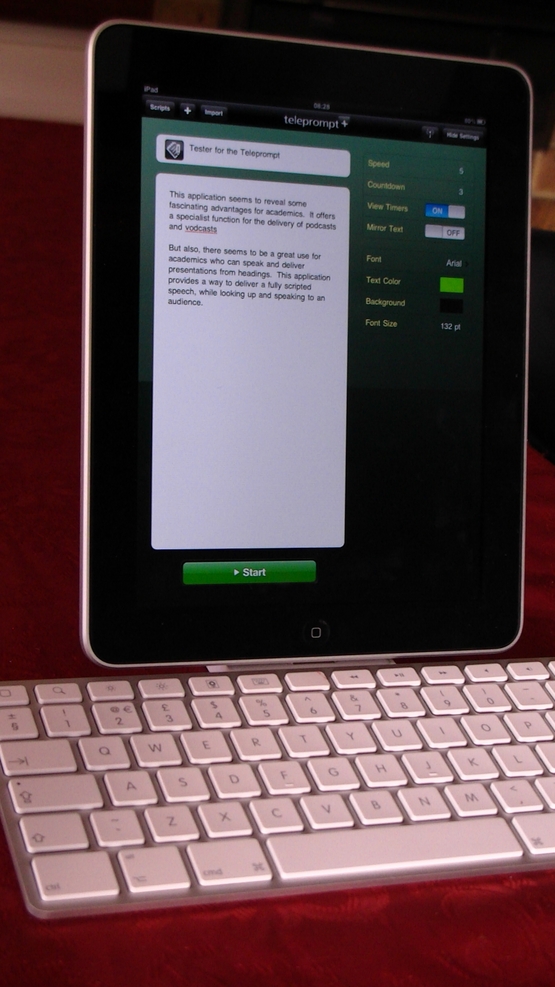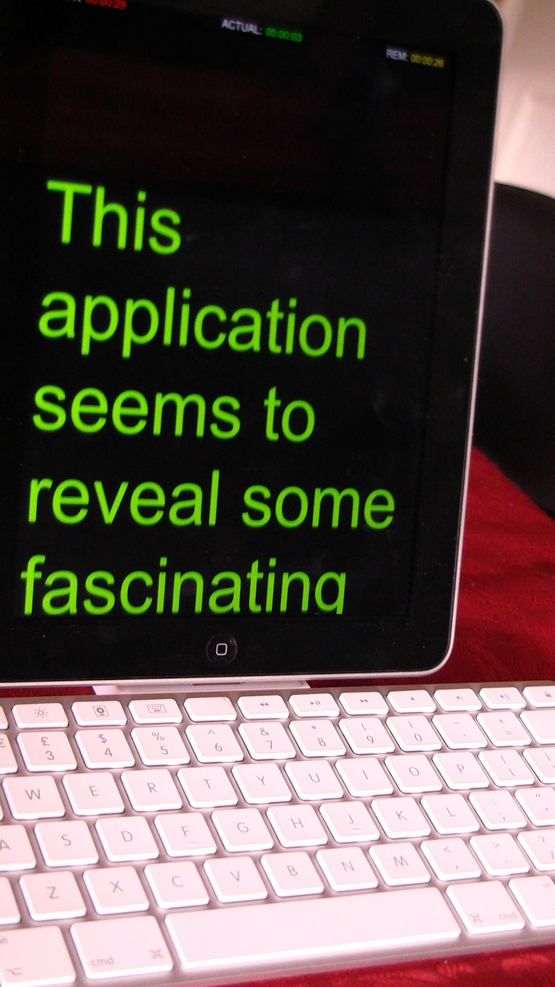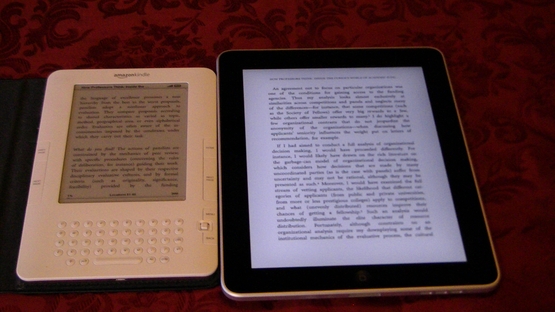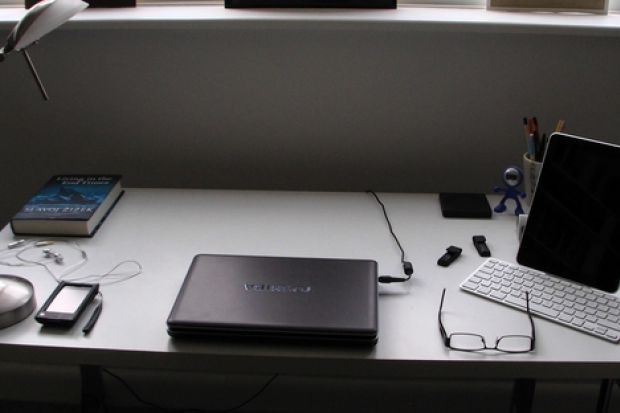Among his 10 rules for successful design, Dieter Rams, the German industrial designer, listed usefulness as a key attribute. Other characteristics included consistency, simplicity, honesty, understandability, unobtrusiveness and innovation. In Gary Hustwit’s Objectified (2009), a feature-length documentary about society’s complex relationship with manufactured objects, Rams anointed Apple as the corporation that best perpetuated his legacy.
Rams made these comments before the release of the iPad. This product has divided critics, raising questions about its purpose. Occupying the space between the smartphone and the laptop computer, the iPad probes our consciousness of technological obsolescence, waste, viral-marketing excesses, public relations and the usefulness of design. While Stephen Fry and the usual Apple advocates and enthusiasts express their “love” for the platform and its “intimacy”, I have yet to be convinced.
However, below I explore some specific functions that academics may extract from the iPad. Two characteristics make it distinctive in the overcrowded technological market: its screen and its mobility, through which students, teachers and researchers can create new ways of reading, writing, watching and thinking. I report not only on my household’s engagement with the device, but also on the iPad applications used by my students. From this early experience, I offer Tara’s 10 uses for the “aca-Pad”.
Photographic-led research
One feature that drew me to the iPad – and makes it distinctive from laptops, netbooks and the iPhone – is its presentation of photographs.
Digital photography has many benefits, including accessibility, cheaper printing costs and the ease and speed of distribution. However, one loss in the movement from analogue to digital photography has been the way in which images are presented and shared.
Enthusiasts have hard drives filled with hundreds of rarely seen digital photographs: they are taken and stored, but are not visible for use. The iPad enables not only the presentation of photographs, but also their cataloguing and bundling for research. For visual ethnographers, semioticians, scholars of tourism and design and marketing researchers, the iPad is an accessible and appropriate platform for displaying, analysing, disseminating, cataloguing and carrying images.
Teaching with screen-based media
The tethering of the iPad to iTunes ties the user to Apple in a way that would make Microsoft blush, or at least put the anti-competition lawyers on speed dial. One of the advantages of this dependency is that screen-based media – including film, television programmes and vodcasts – can be downloaded, played and viewed.
The iPad’s capacity to operate as a self-standing screen for time-shifting and space-shifting media makes it ideal for small-group teaching. It is unobtrusive and mobile. The YouTube application resident on the platform helps ensure that popular culture and user-generated content can be deployed in appropriate and thoughtful ways throughout a seminar or tutorial.
Researching with screen-based media
The iPad’s portable screen encasing downloaded visual media enables staff to conduct research as they move around the world. One difficulty of relying on DVDs for this work is the restrictive nature of region codes. If a British-based scholar wishes to work with a UK-purchased DVD in the US or Singapore, the film will not operate on local hardware (unless it is chipped or multiregional).
Although it is often more expensive to download films and television programmes to the iPod, iPhone or iPad, one advantage is that the material is mobile. As an example, let us consider the interview mentioned above with Rams in Objectified. I own the film on DVD and via an iTunes download. Writing this article while in Australia, my Zone 2 DVD would not operate. The iTunes version was as mobile as its owner.
iTunes U, vodcasts and archived lectures
My husband, Steve Redhead, recognised an innovative use for the iPad straight out of the box. He immediately started to download seminars and sessions from iTunes U and positioned the iPad alongside his laptop computer. He has been watching lectures by cultural theorists Sylvère Lotringer and Paul Virilio for his research, taking notes on his computer while viewing the footage. Originally, it seemed as if he was treating the iPad as a small television in his office, but he was actually using it as a specialist visual archive for his work. He could have viewed the videos on his computer, but found it more effective and efficient to separate watching and note-taking.
I have followed his lead. Before the iPad, I favoured podcasts and audio-only lectures and presentations from iTunes U. On most days over the past few years, I have listened to sonic sessions delivered by great scholars. While the iPad will not replace this function, there is no doubt that the smaller screens of the iPhone and iPod are not conducive to viewing scholarly visual presentations. The iPad has enhanced the usability of university vodcasts in research and teaching: when watching lectures recorded with a static camera, the platform offers an intimacy with the speaker.
For sessions in foreign languages where subtitles are used, the small screens of the iPhone and iPod do not assist viewers. On the iPad screen, subtitles are of an appropriate size and enhance the archival use of materials spoken in foreign tongues.
Music video research
The iPodification of culture has transformed the music video into a self-standing object and commodity for the music industry. Throughout the 1980s, the video was an advertisement for a song, meaning that close studies of this exploratory mode of short filmmaking were marginalised. iTunes not only ensured that the music video gained an independent commercial role in the industry, but also granted scholars access to a rich and underutilised popular-cultural database.
Although the screen is wasted when playing music on the iPad, music videos and album covers benefit. While the iPod decentred the visual, the iPad has returned it to the study of popular music.
Marketing and promotion
Like most academics, I have been involved in marketing, promoting and selling university programmes. Such events require the movement of brochures and media display units. The lightness of the iPad permits staff to carry a high-resolution screen with a built-in speaker to show looped advertisements, university web pages, and staff and student profiles.
Assistance in the construction and delivery of lectures, public speeches and media presentations
Much iPad functionality emerges through the apps developed and released by third parties. For artists, designers, musicians and gamers, their needs are well served. By contrast, academics are a small community and market for any media and the iPad is no exception.
However, there is an app that was developed for delivering media presentations that has revealed unexpected uses for scholars. The ProPrompter app is a teleprompter for speakers. Used well by Barack Obama and poorly by Bush the Younger, it provides a great opportunity for podcasters, vodcasters and lecturers to import a script into the iPad and utilise scrolling text.


Specialist note-taking facility with attendant sonic recording
One of the most innovative apps, with profound uses for both academics and administrators, is SoundPaper. It enables the user to take notes from a meeting or an event. Concurrently, the session is recorded. The user can review the typed notes and – when hovering the cursor over a phrase – the synchronous soundtrack is activated to play the actual words used.
Such an application has multiple uses, including MPhil/PhD upgrade meetings, professional development sessions with staff or interview assistance and training for students. Any event where an accurate record of an event is required and where sound can assist the use of notes is enhanced by this remarkable app.
Besides this synchronised sound and text function, an array of recorders are also available for the iPad. I still use the Zoom range to capture oral testimony and podcasting, but I recently conducted a workshop where I needed to guarantee that staff views were recorded. The iPad provided a backup for my specialist equipment. Using the Sound Recorder app, I set up the iPad as an unobtrusive recorder before the seminar commenced, ensuring that the session was captured accurately.
Student portfolios
Many uses of the iPad improve access to already existing media. It also has a great capacity to store and disseminate student work.
Upon seeing the iPad, one of my MA students, Arturas Gudavicius, realised that it offered a way for artists and media practitioners to carry and present their films, photographs, digital storytelling narratives, community media projects and soundscapes in interviews and consultancies. It can provide a powerful and appropriate visual and sonic portfolio – an ideal way to convey digital material to new audiences.
iPad books
Perhaps the most contentious use of the iPad is its relationship to books, newspapers and magazines. From Steve Jobs’ launch of the product, he stressed its ability to transform publishing. Certainly, a new type of reading is promoted on a screen when compared with paper. Embedded sound and vision enhance the encircling text.
Jobs was not the ideal person to summon the future for publishing. He once attempted to marginalise Amazon’s e-reader, the Kindle, telling The New York Times in 2008: “It doesn’t matter how good or bad the product is, the fact is that people don’t read any more. Forty per cent of the people in the US read one book or less last year. The whole conception is flawed at the top.”
Jobs was wrong. He made one crucial mistake. The millions who do read are voraciously committed, visible, affluent and important to other creative industries. To ignore this market restricted iTunes products, but also blocked new reading opportunities for underserviced communities. By 2010, there were more book apps than games for the iPhone and iPod touch.
Amazon’s Kindle was the game changer in e-publishing. However, its inability to display colour and video remains a weakness of the product, as does its design.
I have used the Kindle since its release in the UK. E-ink has generated a parity of experience with print on paper. While the rapid downloading of books has been beneficial and convenient, for long research days the platform has not made for a comfortable reading experience.
The iPad offers a different service and distinct (and better) type of experience. Amazon appears to have admitted this by creating a Kindle app for the iPad, so that all Kindle books can now be read on its competitor.
This also means that the same books can be viewed on both platforms for a direct comparison, and the iPad is superior. It is easier to negotiate pages and read content.

The iBook app resident on the iPad offers users the capacity to turn virtual pages. Although a design stunt, it is also a seamless way of reading, particularly in comparison to clicking on to the next page as seen with the Kindle.
Also, Apple opted for ePub for the iPad, the free and open book standard from the International Digital Publishing Forum. The Kindle uses proprietary formats that – in the long term – will limit its usefulness.
The key challenge for the iPad will be the relationships Apple forms with publishers for not only electronic versions of print-based books, but also for new types of material. Compared with the Kindle, currently there is not a wide array of books available to download or purchase via iTunes.
The iBookstore has potential, but has yet to reach its full capacity. More than half of its books are free and supplied from Project Gutenburg. Purchasable publications are dominated by mainstream fiction and self-help text, and the academic range of material is limited.
Certainly, some leading publishers have committed to the iPad, including Penguin, Simon & Schuster, HarperCollins, Macmillan and Hachette. Random House has not. Penguin is using its relationship with Apple to reconsider the meaning of the book in an iPad environment. Specialist new publishers such as Alvercom have offered services to writers for the iPhone and iPod touch and are about to enter the iPad market.
The iPad is also an ideal platform for displaying academic articles, papers and journals. One of my US-based MA students, Mick Winter, initially bought the iPad to reduce the need to print web-housed refereed scholarship. He was right: there are benefits in using the iPad to read open-access journals.
While my husband has used the iPad to view video, I am using it as a display device for digital documents. I do not cut and paste material from the online environment, preferring to take independent notes from all sources, on and offline.
Using the platform’s high-quality screen to display scholarship not only reduces printing, but also offers portable content for travelling scholars. Questia has created an app to this end, and a range of article-bundling services are available.
I am interested in how new forms of reading, writing and publishing are emerging from the iPad. There is a huge potential market and vast intellectual opportunities. The Kindle presents printed text, but the iPad – through its larger screen – is more versatile for displaying diverse content.
Just another gadget?
The iPad was introduced as a universal encoder and decoder of digital material. It is not. It does not replace existing functions, hardware or software: typing, formatting and transferring text is easier and much more efficient with conventional computers.
Word processing is an area where the iPad’s high-quality screen and mobility – its two great attributes – are not sufficient to replace the functionality of other devices. The iPad is available in 16, 32 and 64 gigabyte versions, but this is not enough storage to contain the contents of my iPod, let alone a laptop. Also, its lack of support for Adobe Flash inhibits the experience of web searching.
There is no doubt that the iPad will take on the Kindle and win that corporate battle, but as things stand, the former will not replace the consumer need for computers, iPhones and (in my case, anyway) iPods with their much greater capacity for music, podcasts and iTunes U material.
The iPad is another gadget. It offers new ways of thinking, seeing, reading and downloading. It has the potential to display and consume media. Its tight integration with the iTunes Store is convenient, and its constantly developing apps enhance its functionality. But I will continue to use the iPod for listening to sonic-media presentations, the Zoom Hn4 for recording sound, and a laptop for writing and word processing. However, I will move from the Kindle to the iPad for e-book reading.
Of most interest are the new uses that are emerging from this fascinating object. Innovative ways of downloading, working with, displaying and sharing visual media are enhancing the research and teaching experiences of academics and students.
Matt Brooke-Smith, chief executive of app developer Future Workshops, states that when designing for the iPad, “you can rely on having the user’s attention for a longer period of time. This naturally lends itself to apps that have very rich content – think interactive magazines or books.”
From this realisation, the aca-Pad has potential. Its screen, internal speakers and photographic-management system offer great opportunities. Its accessories, including the keyboard dock, view stands and stylus, add to its capacity.
My household does not regret buying an iPad, but the gadget is simply not an object of digital convergence: instead, it is (just) another platform of digital divergence. Smartphones will continue to be used for telephony and laptops for computer-based functions.
Although the iPad offers a new way to consume content, its associated methods of creating content – such as the iWork suite – are not as successful. This first iPad does not even include a camera.
We live in an age of excessive consumption. Rams believes that “we have too many unnecessary things everywhere”. The iPad has been released in a difficult economic environment, and the question remains whether the product is useful enough to sustain it beyond Apple’s true believers.
Obsolescence is a necessary part of capitalist exchange. As sociologist Thorstein Veblen described in his thesis of “conspicuous consumption”, wastefulness confirms class and status. If a shopper can waste money on extravagant goods and services, they “perform” affluence. The iPad is an object of desire and opportunity: it is also an example of waste.
But for academics, the platform enhances daily teaching and research. In an age when universities’ core functions are under threat, the gadget offers a vision disconnected from the crumbling teaching and learning experiences in our libraries and classrooms.
Register to continue
Why register?
- Registration is free and only takes a moment
- Once registered, you can read 3 articles a month
- Sign up for our newsletter
Subscribe
Or subscribe for unlimited access to:
- Unlimited access to news, views, insights & reviews
- Digital editions
- Digital access to THE’s university and college rankings analysis
Already registered or a current subscriber? Login
